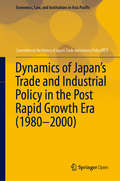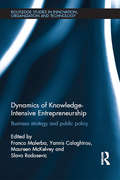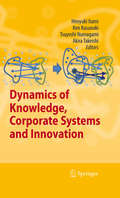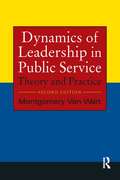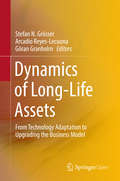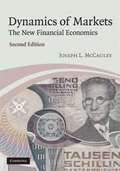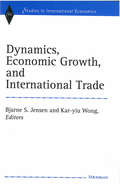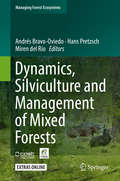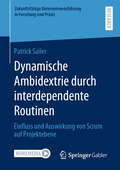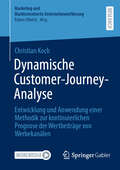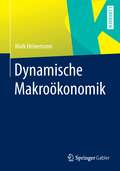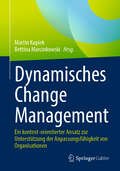- Table View
- List View
Dynamics of Information Systems: Mathematical Foundations
by Panos M. Pardalos My T. Thai Robert Murphey Alexey SorokinThis book presents recent developments and results found by participants of the Third International Conference on the Dynamics of Information Systems, which took place at the University of Florida, Gainesville FL, USA on February 16-18, 2011. The purpose of this conference was to bring together scientists and engineers from industry, government, and universities to exchange knowledge and results in a broad range of topics relevant to the theory and practice of the dynamics of information systems. Dynamics of Information plays an increasingly critical role in our society. The influence of information on social, biological, genetic, and military systems must be better understood to achieve large advances in the capability and understanding of these systems. Applications are widespread and include: research in evolutionary theory, optimization of information workflow, military applications, climate networks, collision work, and much more. Dynamics of Information plays an increasingly critical role in our society. The influence of information on social, biological, genetic, and military systems must be better understood to achieve large advances in the capability and understanding of these systems. Applications are widespread and include: research in evolutionary theory, optimization of information workflow, military applications, climate networks, collision work, and much more.
Dynamics of Innovation in Industry
by James M. UtterbackIn this chapter, the author examines important moments of innovation in the history of the typewriter, extracting some common patterns in order to begin constructing a general model for implementing innovative strategies to ensure long-term success.
Dynamics of Institutional Change in Emerging Market Economies: Theories, Concepts and Mechanisms (Contributions to Economics)
by Nezameddin Faghih Ali Hussein SamadiEconomic, social, political, and cultural institutions, and institutional change reflect shared journeys of humanity throughout history. This edited volume explores dynamics, trends, and implications of institutional change in emerging markets, by focusing on theories, concepts, and mechanisms of institutional development. Presenting research by eminent scholars and experts engaged in education and research, they address and discuss the most recent issues in the field, reveals new insights into the dynamics of institutional change for researchers interested in development of new theories and comparative studies, especially in the era of emerging markets.Topics range from dynamics of institutional change and development within the Group of Twenty (G20), and the European Union with an assessment of Brexit impact, to institutional quality measurement, public administration reforms, as well as emergent topics such as the effects of energy and globalization. It provides new international business theories, and sheds light on the way to global peace by producing a better understanding of the dynamics of historical change. The book is intended for a wide range of global audience, and should serve as a useful reference in education and research, offering innovative and productive discussions, as well as satisfy scholarly and intellectual interests, regarding institutional development and a broad spectrum of its interactions with functioning of markets and economies.
Dynamics of International Business
by Prem Ramburuth Christina Stringer Manuel Serapio Prem Ramburuth Christina StringerDynamics of International Business: Asia-Pacific Business Cases brings the challenges and complexities of the contemporary international business environment into the classroom. These authentic case studies, based on recent research and events, enable students to engage with the economic, social, political and intercultural factors that impact on international business and understand how these factors are addressed in the real world. Designed to facilitate a problem-based learning approach, the cases in this book: • draw on a diverse range of businesses and industries – from seafood to video games to renewable energy • illustrate fundamental themes and concerns within global business, including ethics, sustainability, emerging markets and cultural and legal differences • span many countries across the Asia-Pacific region • include discussion questions that encourage students to apply international business theory in the context of realistic scenarios • include references and suggestions for further reading. Extra resources for instructors, including case synopses and learning objectives, are available on the companion website at www. cambridge. edu. au/academic/internationalbusiness.
Dynamics of International Business: Comparative Perspectives of Firms, Markets and Entrepreneurship
by Andrea ColliThe Dynamics of International Business offers a comparative, chronological overview of the strategic and structural evolution of international firms. Organized around eras of global economic development, the text synthesizes research on the internationalization of firms, highlighting crucial turning points in the evolution of the international economy. A particular emphasis is placed on the relationship between historical evidence and the theoretical frameworks available for its interpretation. Each period is illustrated by a selection of short case studies from a variety of industry sectors, including the Levant Company, Nestlé, Singer, Saint Gobain and NEC. An essential textbook for courses in business and economic history, this book will also be a valuable resource for scholars and students of international business more generally.
Dynamics of Japan’s Trade and Industrial Policy in the Post Rapid Growth Era (Economics, Law, and Institutions in Asia Pacific)
by RIETIThis open access book provides an in-depth examination of Japan's policy responses to the economic challenges of the 1980s and '90s. While MITI's earlier role in promoting rapid growth has been addressed in other studies, this volume, based on official records and exhaustive interviews, is the first to examine the aftermath of rapid growth and the evolution of MITI's interpretation of the economy's changing needs. Covering such topics as the oil shocks, trade conflict with the United States, and the rise and collapse of the so-called bubble economy, it presents a detailed analysis and evaluation of how these challenges were interpreted by government officials, the kinds of policies that were enacted, the extent to which policy aims were realized, and lessons for the longer term. This book is recommended especially to officials of countries concerned about the challenges that follow on high economic growth and to readers interested in Japan’s contemporary economic history.
Dynamics of Knowledge Intensive Entrepreneurship: Business Strategy and Public Policy (Routledge Studies in Innovation, Organizations and Technology)
by Franco Malerba Yannis Caloghirou Maureen McKelvey Slavo RadosevicKnowledge intensive entrepreneurship lies at the core of the structural shift necessary for the growth and development of a knowledge based economy, yet research reveals that the EU has fewer young leading innovators, and Europe’s new firms do not adequately contribute to industrial growth. This is especially true in the high R&D intensive, high-tech sectors. This structural malaise, undermining Europe’s growth potential, is well diagnosed, but poorly understood. This volume fills this important gap by exploring new firms that have significant knowledge intensity in their activity and develop and exploit innovative opportunities in diverse sectors. Through an evolutionary and systemic approach to entrepreneurship, focusing on knowledge intensive entrepreneurship as both a micro and a macro phenomena and analyzing firms in the context of various socio-economic models, the authors explore firms creation and origins around the world, their organization, strategies and business models as well as the role of innovation systems and institutions in their formation and growth. This comprehensive research text is vital reading for academics, researchers and students of high-tech and knowledge intensive entrepreneurship as well as those with an interest in industrial dynamics, innovation management and public policy.
Dynamics of Knowledge, Corporate Systems and Innovation
by Ken Kusunoki Hiroyuki Itami Tsuyoshi Numagami Akira TakeishiThe theme of the book exactly matches the title: the dynamics of knowledge, the corporate system and innovation. Knowledge is created and accumulated in the corporate system, which seeks to utilize it to introduce innovation to the market and society. Corporate organizations generate new knowledge through their in-house R&D activities, and introduce new products and services to the market by combining their own new knowledge and the knowledge generated by others, e.g. universities. Thus, the corporate system is the essential linchpin between knowledge and innovation, and the interactive dynamics between knowledge, the corporate system, and innovation are extremely important. To understand and guide innovative activities in the society, deeper insights into these dynamics are crucial. This book is a step forward in that direction.
Dynamics of Leadership in Public Service: Theory and Practice
by Montgomery Van WartEminently readible, current, and comprhensive, this acclaimed text sets the standard for instruction in
Dynamics of Long-Life Assets
by Stefan N. Grösser Arcadio Reyes-Lecuona Göran GranholmThis book is published under a CC BY-NC 4. 0 license. The editors present essential methods and tools to support a holistic approach to the challenge of system upgrades and innovation in the context of high-value products and services. The approach presented here is based on three main pillars: an adaptation mechanism based on a broad understanding of system dependencies; efficient use of system knowledge through involvement of actors throughout the process; and technological solutions to enable efficient actor communication and information handling. The book provides readers with a better understanding of the factors that influence decisions, and put forward solutions to facilitate the rapid adaptation to changes in the business environment and customer needs through intelligent upgrade interventions. Further, it examines a number of sample cases from various contexts including car manufacturing, utilities, shipping and the furniture industry. The book offers a valuable resource for both academics and practitioners interested in the upgrading of capital-intensive products and services. "The work performed in the project "Use-It-Wisely (UiW)" significantly contributes towards a collaborative way of working. Moreover, it offers comprehensive system modelling to identify business opportunities and develop technical solutions within industrial value networks. The developed UiW-framework fills a void and offers a great opportunity. The naval construction sector of small passenger vessels, for instance, is one industry that can benefit. " Nikitas Nikitakos, Professor at University of the Aegean, Department of Shipping, Trade, and Transport, Greece. "Long-life assets are crucial for both the future competiveness and sustainability of society. Make wrong choices now and you are locked into a wrong system for a long time. Make the right choices now and society can prosper. This book gives important information about how manufacturers can make right choices. " Arnold Tukker, Scientific director, Institute of Environmental Sciences (CML), Leiden University, and senior scientist, TNO.
Dynamics of Markets: The New Financial Economics (2nd edition)
by Joseph L. MccauleyThis second edition presents the advances made in finance market analysis since 2005. The book provides a careful introduction to stochastic methods along with approximate ensembles for a single, historic time series. The new edition explains the history leading up to the biggest economic disaster of the 21st century. Empirical evidence for finance market instability under deregulation is given, together with a history of the explosion of the US Dollar worldwide. A model shows how bounds set by a central bank stabilized FX in the gold standard era, illustrating the effect of regulations. The book presents economic and finance theory thoroughly and critically, including rational expectations, cointegration and arch/garch methods, and replaces several of those misconceptions by empirically based ideas. This book will be of interest to finance theorists, traders, economists, physicists and engineers, and leads the reader to the frontier of research in time series analysis.
Dynamics of Organizational Ambidexterity: Studies from a Processual Constructivist Perspective (Markt- und Unternehmensentwicklung Markets and Organisations)
by Elena Krause-SöhnerElena Krause-Söhner explores how the dynamics of organizational ambidexterity can be managed in complex organizations. This is a relevant question as today’s organizations and the individuals within them face the challenge of focusing on short term improvements while simultaneously targeting long-term innovation in a dynamic environment. Drawing on a practice-based perspective and the view of organizations as socially constructed and constantly changing entities, organizational enacting and constructing change activities are investigated based on profound conceptual and empirical base in an industry and service context. This book derives implications for both the theoretical discourse and for practitioners.
Dynamics of Poverty in Rural Bangladesh
by Noriatsu Matsui Yukio Ikemoto Pk. Md. RahmanThe study of poverty dynamics is important for effective poverty alleviation policies because the changes in income poverty are also accompanied by changes in socioeconomic factors such as literacy, gender parity in school, health care, infant mortality, and asset holdings. In order to examine the dynamics of poverty, information from 1,212 households in 32 rural villages in Bangladesh was collected in December 2004 and December 2009. This book reports the analytical results from quantitative and qualitative surveys from the same households at two points of time, which yielded the panel data for understanding the changes in situations of poverty. Efforts have been made to include the most recent research from diverse disciplines including economics, statistics, anthropology, education, health care, and vulnerability study. Specifically, findings from logistic regression analysis, polychoric principal component analysis, kernel density function, income mobility with the help of the Markov chain model, and child nutrition status from anthropometric measures have been presented. Asset holdings and liabilities of the chronically poor as well as those of three other economic groups (the descending non-poor, the ascending poor, and the non-poor) are analyzed statistically. The degrees of vulnerability to poverty are examined by years of schooling, landholding size, gender of household head, social capital, and occupation. The multiple logistic regression model was used to identify important risk factors for a household's vulnerability. In 2009, some of the basic characteristics of the chronically poor were: higher percentage and number of female-headed households, higher dependency ratio, lower levels of education, fewer years of schooling, and limited employment. There was a low degree of mobility of households from one poverty status to another in the period 2004-2009, implying that the process of economic development and high economic growth in the macroeconomy during this time failed to improve the poverty situation in rural Bangladesh.
Dynamics of Rational Negotiation: Game Theory, Language Games and Forms of Life
by Margit Gaffal Jesús Padilla GálvezThis book uses game theory to analyze the strategies developed in negotiation processes. Offering a detailed analysis of competition and cooperation, it explores various bargaining strategies that result from the application of Nash equilibrium and mixed strategies. Employing a blend of game theory and real-world examples, the authors describe typical negotiation scenarios and unveil the art of negotiation strategy – dissecting both competitive and cooperative tactics.This comprehensive analysis explores the multifaceted dimensions of negotiation, highlighting not only formal aspects but also the economic, social, political, and human factors at play. The authors discuss the basic structures of cooperative and non-cooperative games and conduct a comprehensive analysis of the language games that take place in negotiations. They examine how negotiators belonging to different forms of life can trade with each other when their respective language games are different and prone to misinterpretation. The book also probes arbitration and mediation as conflict-resolution tools within this intricate landscape. Designed for the curious minds seeking insight into negotiation strategies, as well as students and scholars of diverse fields, this book fosters an understanding of negotiation's labyrinthine pathways. "Dynamics of Rational Negotiation" unlocks the door to negotiation's complexities, inviting readers to unravel the layers of human interaction.
Dynamics of the Mixed Economy: Toward a Theory of Interventionism (Routledge Foundations of the Market Economy)
by Sanford IkedaDynamics of the Mixed Economy applies the insights of modern Austrian political economy to examine economic policy in mixed economies. It compares and contrasts standard approaches to the growth of the state (including public choice) with that of modern Austrian political economy; examines in detail the nature and operation of the interventionist process in the context of nationalization, regulation and the welfare state; analyzes conditions that produce instability under laissez-faire capitalism; argues that the interventionist process is a 'spontaneous order'; and offers several 'pattern predictions' regarding the character and behaviour of really existing economies.
Dynamics, Economic Growth, and International Trade
by Bjarne S. Jensen Kar-Yiu WongWhile endogenous growth theory has claimed success in modeling various factors of growth and providing an analysis of sustainable economic growth, most of the growth models in published work are for closed economies. The omission of international trade, which is often regarded as the engine of growth, greatly reduces their usefulness. The theory of international trade, on the other hand, is characterized by models that are mainly static. While interest in the dynamics of trade has been growing, there is still little work in this area. The success of the newly industrialized economies that have adopted trade-oriented policies suggests how limited present trade theory is in explaining and analyzing the growth of these economies. The work collected here serves to bridge the "old" growth theory and "new" growth theory; merge growth and trade theory; suggest new analysis and techniques of economic growth; and provide analysis of new issues related to growth and trade. The first chapter surveys endogenous growth and international trade and critically reviews the endogenous growth theory with a unified framework, covering the work on both closed and open economies. Three chapters examine the dynamics of some basic trade models; two chapters focus on growth and trade with endogenous accumulation of human and public capital; two chapters on economic growth, technological progress, and international trade; and two chapters on growth and international factor movements.
Dynamics, Silviculture and Management of Mixed Forests (Managing Forest Ecosystems #31)
by Hans Pretzsch Andrés Bravo-Oviedo Miren Del RíoThe capacity of mixed forests to mitigate climate change effects by increasing resilience and lowering risks is pinpointed as an opportunity to highlight the role of tree species rich forests as part of complex socio-ecological systems. This book updates and presents the state-of-the-art of mixed forest performance in terms of regeneration, growth, yield and delivery of ecosystem services. Examples from more than 20 countries in Europe, North Africa and South America provide insights on the interplay between structure and functionining, stability, silviculture and optimization of management of this type of forests. The book also analyses the role of natural mixed forests and mixed plantations in the delivery of ecosystem services and the best modelling strategy to study mixed forest dynamics. The book is intended to serve as a reference tool for students, researchers and professionals concerned about the management of mixed forests in a context of social and environmental change.
Dynamique De Groupe Et Création D'équipe: Un Manuel
by Hiriyappa BAvez-vous déjà demandé ce qu'il faut pour devenir un professionnel accompli ? Ce livre vous prend par le poignet et vous guide vers le succès. Il renforce le fait qu'une équipe est toujours plus maligne que les solitaires. La méthodologie heuristique suivie dans ce livre, simple et facile à suivre, vous permet de vous y référer à tout moment. Les idées sont présentées sous forme de liste pour en faciliter la lecture. Ayez une carrière réussie.
Dynamische Ambidextrie durch interdependente Routinen: Einfluss und Auswirkung von Scrum auf Projektebene (Zukunftsfähige Unternehmensführung in Forschung und Praxis)
by Patrick SailerIn diesem Buch wird die dynamische Entwicklung von Ambidextrie in Projekten durch interdependente Routinen auf fundiert-theoretischer sowie feingranular-empirischer Basis konzipiert. Um bisherige Schwachstellen der Forschung zu Ambidextrie in Projekten zu beseitigen, zeigt Patrick Sailer die Wirkung von Scrum als eine agile Vorgehensweise auf die Entwicklung von Ambidextrie auf. Damit liefert der Autor wichtige theoretische Beiträge in den Bereichen Ambidextrie, Routinen und Projektmanagement.
Dynamische Customer-Journey-Analyse: Entwicklung und Anwendung einer Methodik zur kontinuierlichen Prognose der Wertbeiträge von Werbekanälen (Marketing und Marktorientierte Unternehmensführung)
by Christian KochIn dem vorliegenden Buch wird eine neuartige Methodik zur kontinuierlichen Prognose der Wertbeiträge von Werbekanälen im Rahmen von Mehrkanalstrategien präsentiert und auf Basis eines umfangreichen Datensatzes aus über 49.000 realen Customer Journeys getestet. Durch eine dynamische Verarbeitung von Customer-Journey-Daten und die Variation von Datenerhebungszeiträumen können Werbetreibende die zukünftigen Wertbeiträge von Werbekanälen genauer prognostizieren und ihre Werbebudgets zielgerichteter einsetzen. Neben den in Rahmen dieses Werkes verwendeten Markov-Graphen kann die entwickelte Methodik auch auf zahlreiche weitere Attributionsmodelle und Untersuchungsgegenstände angewendet werden. Dies macht sie sowohl für die akademische Forschung als auch für praktische Anwendungen äußerst relevant.
Dynamische Disposition
by Timm GudehusDie dynamische Disposition ermöglicht marktgerechte Lieferzeiten und kostenoptimale Lieferfähigkeit, sie verhindert überhöhte oder unzureichende Bestände. In dem Buch werden Strategien, Algorithmen und Verfahren der dynamischen Auftrags-, Bestands- und Fertigungsdisposition allgemein verständlich beschrieben und anhand von Beispielen demonstriert. Mithilfe des Regelwerks kann die dynamische Disposition in allen Branchen organisiert und implementiert werden. Die erweiterte 3. Auflage zeigt Potenziale für Serviceverbesserung und Kosteneinsparung auf.
Dynamische Kapazitätssteuerung bei kundenindividueller Auftragsproduktion in der stahlverarbeitenden Industrie
by André HintschesHersteller kundenindividueller Erzeugnisse sehen sich einerseits mit einer Vielzahl volatiler Kundenaufträge und andererseits einem weitgehend inflexiblen Kapazitätsangebot in Produktions-netzwerken konfrontiert. Aus diesem Spannungsfeld erwächst die Notwendigkeit, die betriebs-wirtschaftliche Vorteilhaftigkeit von Kundenaufträgen im Kontext einer unsicheren, zukünftigen Auftragslage zu ermitteln und bei der Auftragsannahme geeignet zu berücksichtigen. André Hintsches führt vor dem Hintergrund zahlreicher Unsicherheitstreiber eine Systematik zur dynamischen Berechnung von Bid-Preisen ein. Hieraus entwickelt er ein Verfahren zur dynamischen Kapazitätssteuerung bei kundenindividueller Auftragsproduktion und greift damit einen Themenkomplex auf, der von hoher praktischer Bedeutung und Aktualität gekennzeichnet ist.
Dynamische Makroökonomik
by Maik HeinemannDas Lehrbuch behandelt die dynamische makrökonomische Theorie im geschlossenen Modellrahmen des Ramsey-Modells. Mit der Wachstums-, Konjunktur- und Geldtheorie werden die Hauptgebiete der Makroökonomik behandelt. Zusätzlich werden aber auch Verteilungsaspekte berücksichtigt. Exemplarisch wird gezeigt, wie sich die dynamische makrökonomische Theorie zur quantitativen Analyse wirtschaftspolitischer Fragestellungen und auch zur Untersuchung der Verteilungswirkungen wirtschaftspolitischer Maßnahmen nutzen lässt. Das Buch gibt einen Einblick in die Methoden, die in der dynamischen Makroökonomik zur Anwendung kommen und bietet damit die Grundlage für eine vertiefende Auseinandersetzung mit den einzelnen Themengebieten.
Dynamische Mitarbeiterführung: Achtsam und flexibel Führungssituationen meistern (essentials)
by Marco FurtnerMarco Furtner beschreibt in diesem essential einen integrativen Führungsansatz, welcher die Vorzüge verschiedener Arten von Führungsverhalten für unterschiedliche Führungssituationen aufzeigt. Die jeweilige situative Angemessenheit von direktivem, kontrollierendem, aversivem, transaktionalem, transformationalem und ermächtigendem Führungsverhalten wird beschrieben und mit praktischen Beispielen belegt. Zudem werden mit der passiven und Laissez-faire-Führung zwei sehr ineffektive Formen von Führungsverhalten dargelegt. Eine achtsame Führungskraft ist sich ihrer selbst, ihrer Umwelt und der jeweiligen Führungssituation bewusst. Sie verfügt über ein breites Verhaltensspektrum, welches flexibel und dynamisch an bestimmte Führungssituationen angepasst werden kann.
Dynamisches Change Management: Ein kontext-orientierter Ansatz zur Unterstützung der Anpassungsfähigkeit von Organisationen
by Martin Kupiek Bettina MarcinkowskiDas Buch stellt einen kontext-orientierten, dynamischen Ansatz für komplexe Veränderungsprojekte in Organisationen vor. Die Herausgeber zeigen anhand der soziologischen Systemtheorie einen Referenzrahmen auf, der nicht nur die klassischen Aspekte der Veränderungstheorie thematisiert, sondern auch das Zusammenspiel von formaler und informeller Ebene sowie der Schauseite (Außenwirkung) von Organisationen verdeutlicht. Eine Referenz an die Theaterwissenschaften – „wenn Luhmann auf Shakespeare trifft“ – verdeutlicht die Eigenarten in der Kommunikation nach außen. Das organisationale Change Management bezieht sich dabei nicht nur auf die Strategien und deren Umsetzung, sondern berücksichtigt vor allem den schnellen Anpassungsbedarf in Organisationen. Ausgehend von der Organisationstheorie werden sowohl die formalen als auch die informalen Aspekte der Struktur und der Kultur einer Organisation in den Vordergrund gestellt und die emotionale Seite des Wandels betont. Zusätzlich zur Emotionstheorie werden in den Beiträgen das strategische Management, Kommunikation, Human Resource Management und die Außenwirkungen der Organisation thematisiert. Das Buch ist ein Hilfsmittel für jeden, der ein Veränderungsprojekt leitet oder die Anpassungsfähigkeit des Unternehmens unterstützen möchte.




